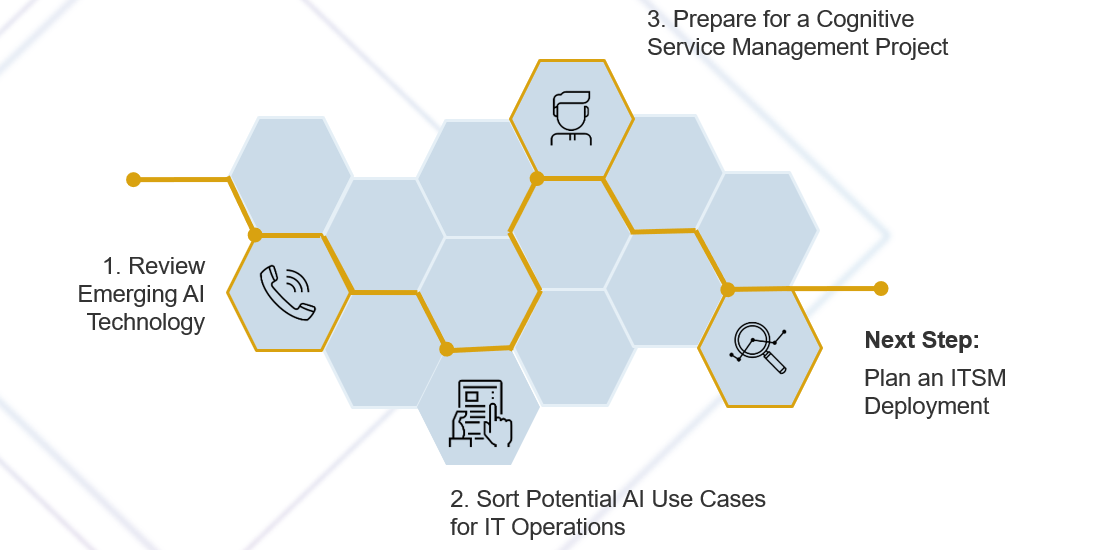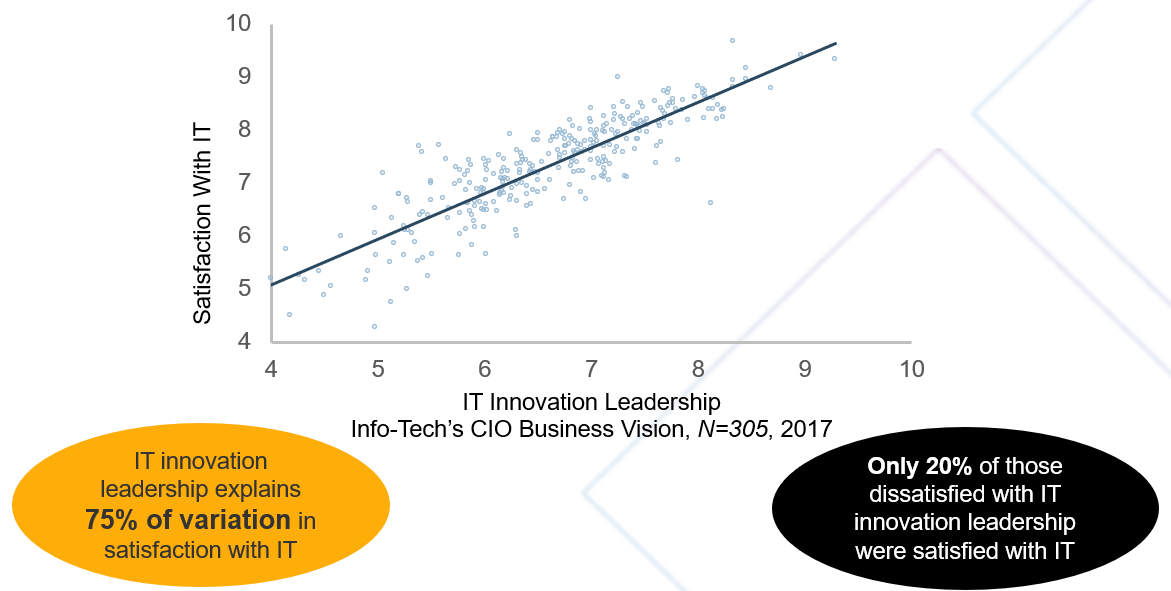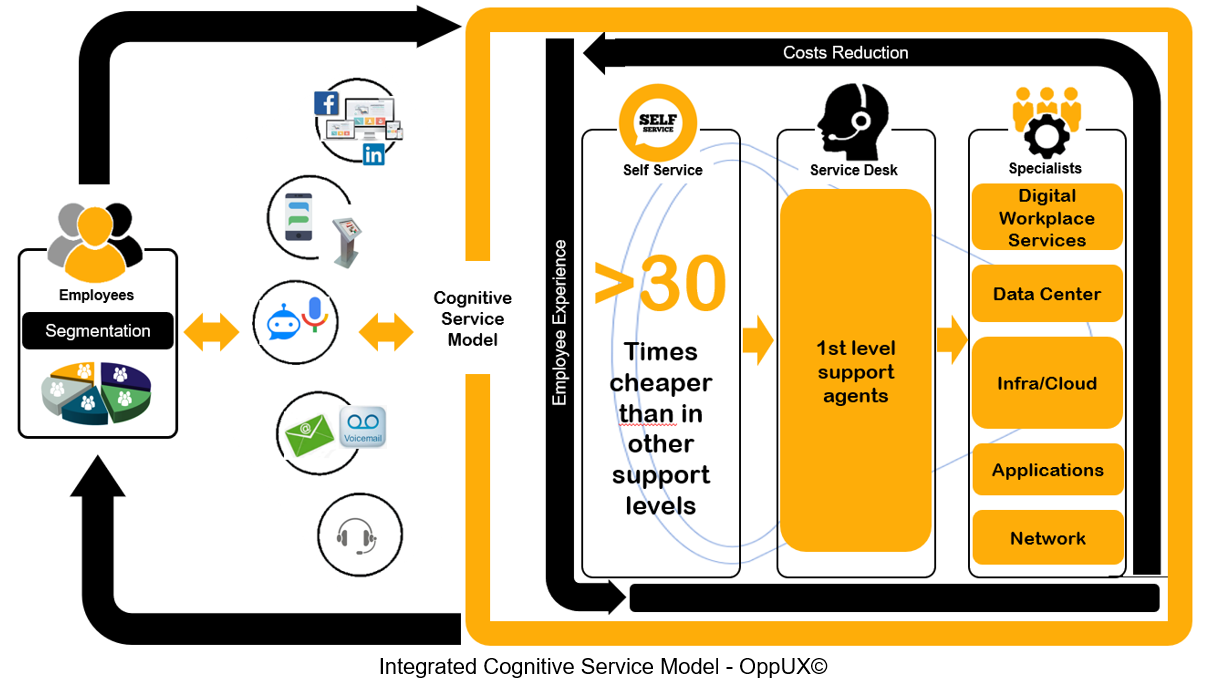Cognitive service management is the application of artificial intelligence tools to service management processes. The new technology promises to enhance existing IT operations processes with natural language processing and machine learning applications, which will improve service quality and reduce service costs.
These are early days in the adoption cycle, however. How vendors will instantiate this new technology, and whether the promised return on investment materializes, remains to be seen.
For the moment, you can take steps to prepare your organization for the coming of AI-assisted ITSM operations. Organizing your knowledgebase, implementing a quality CMDB, and adopting a culture of self-service will prepare you for the future and improve existing IT operations whatever the outcome of the AI revolution.
The evolution of natural language processing and machine learning applications has led to specialized AI-assisted toolsets that promise to improve the efficiency and timeliness of IT operations. Vendors sometimes refer to these applications as cognitive service management (CSM) tools. However, IT operations functions in most organizations are not yet mature enough to take advantage of AI-assisted toolsets. AI-assisted toolsets are generating a considerable amount of media attention. However, vendors have yet to deploy many features under discussion. Early adopters willing to absorb experimentation costs are in the process of deploying the first use cases.
Don’t fall prey to the AI-bandwagon effect. AI-assisted innovations will support shift-left strategies through natural language processing and machine learning applications. However, the return on your AI investment will depend on whether it helps you meet an actual business goal. AI-assisted tools presuppose the existence of mature IT operations, including standardized processes, high-quality structured content focused on the incidents and requests that matter, and a well-functioning IT service management (ITSM) web portal. The success of any ITSM project hinges on adoption. AI projects are no different. If your vision is to power end-user interactions with chatbots and deploy intelligent agents on tickets coming through the web portal, be sure to develop a self-service culture that empowers end users to help themselves and experiment with new tools and technologies.
ITSM tool vendors are making bold promises on the potential of AI-assisted applications to transform IT operations. This storyboard and the associated tools and templates will help you make sense of the hype and prepare for a cognitive service management project:

AI-assisted toolsets are the latest development in a series of changes overtaking IT operations:
- Recently, the rise of self-service, the adoption of ITSM frameworks, and the proliferation of Agile and DevOps have all increased the pace of change in IT operations.
- Fifty-one percent (51%) of IT executives believe the pace of change in the world of ITSM is set to increase (Forbes Insights).
- Executives report that skills, training, and resourcing gaps are currently the most important challenges they face (Forbes Insights).
- AI-assisted tools depend on the effective implementation of these changes, including standardized processes and effective knowledge management.
- The adoption of these tools will help free up time and improve training and resourcing.
AI-assisted toolsets are generating a considerable amount of media attention as vendors compete to increase their market share. Vendors are just getting started, with significant investments in AI-assisted toolsets projected over the next five years. Many of the features under discussion are still prospective. Early adopters who are willing to absorb experimentation costs are in the process of deploying the first use cases. AI is a long-term investment. It takes time and resources to plan, execute, and realize benefits. The return on your investment in AI will depend on whether end users adopt the tools and whether it helps you meet organizational goals. AI-assisted tools also presuppose the existence of mature IT operations functions, including standardized processes; a high-quality, structured knowledgebase; and a suitable self-service portal.
Still, the evolution of AI-assisted IT operations is an opportunity to position IT as an innovator. A clear relationship exists between satisfaction with IT and satisfaction with IT innovation leadership. When stakeholders were asked how satisfied they were overall with their IT departments, their responses strongly correlated with their satisfaction with IT’s innovation leadership.

Case Study
In a massive consumer company, users perceived a high level of bureaucracy in IT services. Usually, the resolution of the requests took a significant time and the users had effects on their productivity due to the exhaustive interaction with the service desk.
Knowing this problem, we started doing an analysis of the service using methodologies such as Customer Journey Map, Design Thinking and Six Sigma Lean, to understand what the user was experiencing and to optimize the operation. These are some of the improvement opportunities detected:
· IT and business support services did not have a standard operating model, which negatively affected the employee experience.
· Users were not receiving the services they required according to their role in the company and the business processes in which they participated.
· There were no cognitive channels of contact with the service and some of the existing ones were obsolete.
· The workflows were not automated, which generated a high percentage of errors and delays, and also the cost of the service was too high.
· They had no metrics to measure customer experience.
The proposed solution consisted of implementing a cognitive service model that started by establishing the segmentation of users, with which we would ensure that we deliver services according to their real needs and also that would provide them with modern channels of interaction. This model should prioritize “Self-service” in order to have a truly agile, economical, safe service with optimized processes. This model had to be integrated seeking, among other advantages, to provide a “single point of contact” to users.
The following is the OppUX © service and operation model, developed and implemented by DilettUX:

Through this solution, our client obtained the following benefits:
· It allowed to have a “Single point of contact” for users and providers
· Obtained an increase in user productivity> 20%
· There was a 30% reduction in the cost of services
· User experience improved 40% for automated transactions.
· The volume of service tickets was reduced by 20%
· The approval cycle was optimized by 25%
· The customer satisfaction indicator (NPS – Net Promoter Score) increased by 30%.
The OppUX © integrated service model represents a modern, innovative and disruptive way of delivering services within companies.
Conclusion
Preparing for a cognitive service management implementation involves deploying familiar best practices that will themselves have a positive impact on your organization. Building a targeted knowledgebase, implementing a configuration management database (CMDB), and deploying self-service tools will improve service management whether or not you implement AI tools successfully. Time spent preparing for the implementation of AI-assisted applications will not be wasted.
DilettUX can help you grasp AI applications, imagine relevant IT operations use cases, and prepare to engage vendors. Contact Us!
“Take care of your employees, they will take care of your customers” – Richard Branson.


